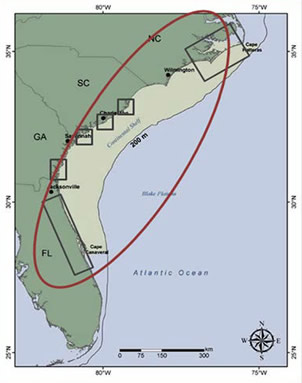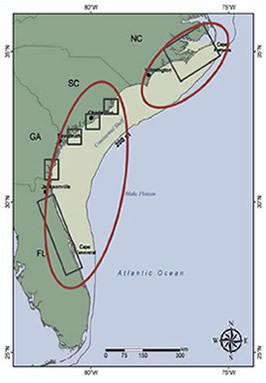Red Drum Population Structure
Red drum, found from the Chesapeake Bay to southern Florida along the U.S. Atlantic coast are managed regionally by the Atlantic States Marine Fisheries Commission (ASMFC), a cooperative management group tasked with regulating interstate fisheries along the East Coast. Currently, East Coast red drum are divided into two stocks: North Carolina and north, and South Carolina and south. The geographic break is supported by physical characteristics of the two groups; for example, fish found in North Carolina tend to live longer and are larger than fish found in South Carolina. In addition to physical traits, scientists often use genetic information as an additional tool to assist in differentiating one stock from another.

Red drum juveniles remain in the estuary for 4 to 5 yrs until they are mature and ready to spawn. At this time, they permanently migrate to the oceanic adult portion of the population. The adults remain offshore for much of the year, but move into the mouths of bays and inlets in the late summer. Decreases in water temperature and day length cue the red drum to begin spawning activity, with peak spawning believed to occur in late August and early September in South Carolina.
SCDNR has had long-term sampling programs in place to monitor both juvenile and adult red drum for over twenty years. Over the last decade, this sampling was expanded to include collection of genetic samples (fin clips) from all captured red drum. Since 2007, SCDNR has collaborated with state agencies in North Carolina, Georgia, and Florida to collect additional fin clips from adult red drum along the entire South Atlantic coast. These efforts have resulted in approximately 3,000 adult red drum fin clips available for genetic analysis. During this study, we compared the DNA of fish captured in South Carolina with those captured in North Carolina, Georgia, and Florida to look for differences between each group and determine the level of genetic structure that occurs. If fish from South Carolina migrate and spawn with fish from other groups, we would expect to see no genetic structure. However, if South Carolina red drum only spawn with other South Carolina fish, we would expect to see strong genetic structure. This genetic analysis would help us determine if the current management units were appropriate for adult red drum along the southeast U.S. Atlantic coast.
We evaluated the data in several different ways. By looking at capture location and timing, we were able to determine that adult red drum exhibit strong site fidelity, meaning that fish return to the same locations year after year to spawn. Then, we considered whether the time of year samples were collected might affect how we interpreted the results. With the understanding that fish migrate into the estuaries to spawn, the data was divided into ‘spawning’ and ‘non-spawning’ groups using water temperature data collected along the South Atlantic coast. Applying the known water temperatures for spawning conditions, the spawning period was determined to be July 1st to October 31st.


When the data were partitioned and evaluated, we determined that there were no differences between states during the non-spawning season, which means that there probably are large migrations of fish along the coast during the months from November to June (Fig. 2). However, when we evaluated samples collected during the spawning season, from July to October, North Carolina fish were genetically different from those captured in South Carolina, Georgia, and Florida (fig. 3). In fact, there was real genetic structure between the states, although weak, which probably means only a small number of fish move between states each year. Most importantly, this information verifies that there is a stock break somewhere between North Carolina and South Carolina, matching the differences we see in size and age of fish, and therefore validating the current two management unit strategy for adult red drum.



